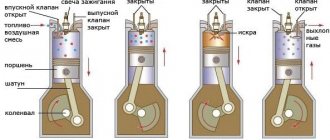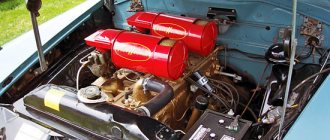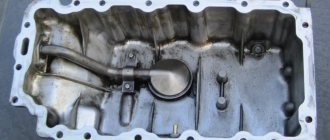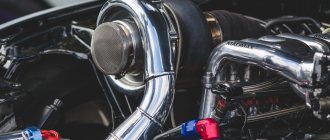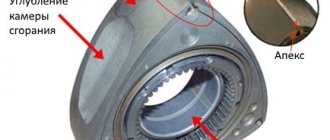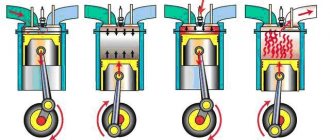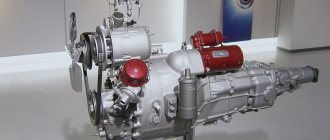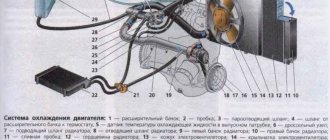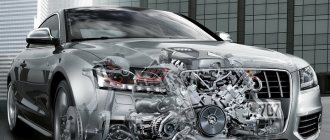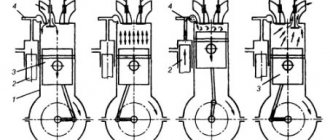Engine duty cycle
The work cycle is a set of processes periodically repeated in a certain sequence that occur in each cylinder of the engine, as a result of which thermal energy is converted into work.
A stroke is the process that occurs in a cylinder when the piston moves from one dead center to another.
If the working cycle is completed in four strokes of the piston, which corresponds to two revolutions of the crankshaft, then an engine with such a cycle is called four-stroke. Each stroke of such an engine has its own name and its own characteristics.
Fig.2. Working cycle of a four-stroke diesel engine : 1-fuel pump; 2-piston; 3-nozzle; 4-air purification; 5-inlet valve; 6-exhaust valve; 7-cylinder
Intake stroke. When the piston moves from TDC to BDC, a space is freed up above it, where clean air from a diesel engine or a mixture of air with finely atomized gasoline (combustible mixture) enters through the opening inlet valve 5 (Fig. 2). The incoming fresh charge is mixed with the remaining exhaust gases from the previous stroke (this mixture is called the working mixture). When approaching BDC, the pressure in the cylinder due to resistance in the intake manifold is below atmospheric and amounts to 0.07. 0.09. The gas temperature at the end of this stroke reaches 40.70°C for a diesel engine and 70.13°C for a carburetor engine.
Compression stroke. When the piston moves from BDC to TDC, the intake valve closes and the air or working mixture entering the cylinder is compressed, as a result of which their temperature and pressure increase. The amount of pressure and temperature increase is determined by the compression ratio of the engine. In a diesel engine, the temperature at the end of the compression stroke reaches 550.750°C, and the pressure is 4.5MPa; In a carburetor engine, the working mixture heats up to 300.430°, and the pressure is 0.8. 1.5MPa.
Expansion stroke. As the piston approaches TDC, fuel is injected into the diesel cylinder through a nozzle, which, moving with heated and compressed air, burns; in this case, the pressure of the gases in the cylinder increases to 6.9 MPa, and their temperature rises to 1800.2000 ° C. Under the influence of the pressure of the expanding gases, the piston moves from TDC to BDC. At the end of this stroke, the temperature of the gases drops to 700.900 ° C, and the pressure to 0.3. 0.5 MPa.
In a carburetor engine, as the piston approaches compression TDC, the combustible mixture is ignited by an electric spark that occurs between the electrodes of a spark plug screwed into the cylinder. As the mixture burns, the gas pressure increases to 3.5. 5 MPa, and the temperature is up to 2100. 2400°. By the end of the expansion stroke of a carburetor engine, the gas temperature drops to 900.1200°, and the pressure to 0.3. 0.35 MPa.
Release stroke. As the piston moves from BDC to TDC, the exhaust valve opens and exhaust gases are pushed out of the cylinder into the atmosphere. In this case, the gas pressure at the end of the stroke decreases to 0.11. 0.12 MPa, and temperatures up to 500.700°C for a diesel engine and 300.400°C for a carburetor engine.
Thus, in a four-stroke engine there is only one expansion stroke - the stroke of the piston under the influence of gas pressure turns the crankshaft and does useful work; this move is called a working move. The remaining strokes - intake, compression and exhaust - are called auxiliary. After the exhaust stroke, the engine cycle repeats.
Source
The fourth measure is release.
The piston moves from BDC to TDC. Through the open exhaust valve, the exhaust gases are pushed out through the exhaust pipe into the environment. At the end of the exhaust stroke, the gas pressure is 0.11 -0.12 MPa, the temperature is 850-1200. After this, the diesel operating cycle is repeated. In two-stroke engines, the time allotted for the working cycle is used more fully, since the exhaust and intake processes are combined in time with the compression and power stroke processes. The operating cycle occurs over 360 degrees (one revolution of the crankshaft).
Engine duty cycles
Duty cycle of a four-stroke carburetor engine
The operation of an internal combustion engine can be represented in the form of systematically repeating processes, which are commonly called work cycles. The engine operating cycle is a series of sequential, periodic, repeating processes in the cylinders, as a result of which the thermal energy of the fuel is converted into mechanical work. In this case, each complete working cycle can be divided into identical (repeating) parts - cycles.
The part of the working cycle completed during the movement of the piston from one dead center to another, i.e., during one stroke of the piston, is called stroke. Engines whose operating cycle is completed in four piston strokes (two revolutions of the crankshaft) are called four-stroke. In the cylinder head, above the combustion chamber (Fig. 1) of a carburetor engine, inlet valves 4 and exhaust valves 6 are installed, controlled by a gas distribution mechanism, as well as a spark plug 5.
The duty cycle of a carburetor four-stroke engine consists of successive strokes of intake, compression, expansion and exhaust.
Intake stroke
As a result of rotation of the crankshaft when starting the engine (manually or using a special device - for example, a crank or an electric starter motor), the piston moves from top dead center (TDC) to bottom dead center (BDC). In this case, the inlet valve 4 is open and the outlet valve 6 is closed. Since the volume of the cylinder quickly increases when the piston moves down (toward BDC), the pressure above the piston decreases to 0.07. 0.09 MPa, i.e. a vacuum is created inside the cylinder - excess vacuum. Inlet valve 3 communicates with a special device - a carburetor, which prepares a combustible mixture of fuel and air. Due to the pressure difference between the carburetor and the cylinder, the combustible mixture is sucked through the open intake valve into the engine cylinder.
If the engine is already running, then the combustible mixture, entering the cylinder from the carburetor, mixes with the residual combustion products from the previous cycle and forms a working mixture. Mixing with the residual combustion products and coming into contact with the heated parts of the cylinder, the working mixture is heated to a temperature of 75.125 °C.
Compression stroke
As the piston approaches BDC, the intake valve closes. Next, the piston begins to move upward (towards TDC), compressing the mixture of air, fuel and residual combustion products that were not removed from the cylinder during exhaust. When the piston moves from BDC to TDC, due to a reduction in the volume of the cylinder with the valves closed, the pressure increases, and the temperature of the working mixture increases (in accordance with Gay-Lussac's law). At the end of the compression stroke, the pressure inside the cylinder rises to 0.9...1.5 MPa, and the temperature of the mixture reaches 270-480 ˚C. At this moment, a high voltage is supplied to the electrodes of the spark plug 5, which causes a spark discharge between them, as a result of which the working mixture ignites and burns. During the combustion of fuel, a large amount of heat is released, due to which the temperature of the gases (combustion products) rises to 2200-2500 ˚C, and the pressure inside the cylinder reaches 3.0...4.5 MPa. The gases begin to expand, moving the piston down toward BDC.
Expansion stroke (power stroke)
Under the pressure of expanding gases, the piston moves from TDC to BDC (both valves are closed). During this period of time (stroke), thermal energy is converted into useful work, therefore the stroke of the piston during the expansion stroke is called the power stroke. When the piston moves to BDC, the volume of the cylinder increases, as a result of which the pressure decreases to 0.3...0.4 MPa, and the gas temperature decreases to 900...1200 ˚C.
Release stroke
As the piston approaches BDC, exhaust valve 6 opens, causing the combustion products of the working mixture to escape out of the cylinder. With further rotation of the crankshaft, the piston begins to move from BDC to TDC. By pushing the exhaust gases through the open exhaust valve, exhaust port 7 and exhaust pipe into the environment. By the end of the exhaust stroke, the pressure in the cylinder is 0.11...0.12 MPa, and the temperature is 600...900 ˚С.
As the piston approaches TDC, the exhaust valve closes, the intake valve opens and the intake stroke begins, giving rise to a new operating cycle.
Diesel engine, operating principle
The fundamental difference between a diesel engine and a gasoline engine is how the fuel-air mixture is formed, ignites and burns. A diesel internal combustion engine does not have spark plugs and, accordingly, ignition of the fuel-air mixture occurs from compression. At the same time, air and diesel fuel are supplied separately. It should also be noted that almost no modern diesel engine can do without a supercharging system, which is used to improve the performance of the unit. Variable geometry turbochargers are used to optimize boost over the widest possible speed range. A diesel unit has a higher efficiency, but it is heavier and produces more torque at low speeds than a gasoline internal combustion engine.
Operating principle of a diesel engine:
How does a diesel engine work and, most importantly, how does fuel ignite in the combustion chamber if this type of unit does not have spark plugs? First, air enters the cylinders. At the end of the compression stroke, when the piston has almost reached top dead center, the air temperature in the combustion chamber reaches high values (about 700-800 degrees) and then diesel fuel is injected into the cylinders, which ignites independently, without spark ignition. However, there are still spark plugs in a diesel unit, but they are glow plugs, not spark plugs, which heat the combustion chamber to make it easier to start the engine in cold weather.
They are a spiral (there are metal and ceramic), can be installed in a vortex chamber or in a pre-chamber (if we are talking about units with a separate combustion chamber) or directly in the combustion chamber (if it is inseparable). When you turn on the ignition, the glow plugs almost instantly, in a matter of seconds, they heat up to temperatures in the region of a thousand degrees and heat the air in the combustion chamber, facilitating the process of self-ignition of the fuel-air mixture.
Diesel engine types:
Motors with a separate combustion chamber are widespread - fuel is injected into a special chamber in the block head above the cylinder and connected to it by a channel, and the combustion process does not occur exactly like in gasoline internal combustion engines. In this vortex chamber, the air flow swirls more intensely, which contributes to more efficient mixture formation and self-ignition, which continues in the main combustion chamber. By the way, diesel engines with a separate combustion chamber are less noisy due to the fact that the use of a vortex chamber reduces the intensity of pressure build-up during self-ignition.
Source
How does a four stroke engine work?
Structurally, the working cycle of a typical four-stroke unit is ensured by the operation of the following elements:
- cylinder;
- piston - performs reciprocating movements inside the cylinder;
- intake valve – controls the process of supplying the air-fuel mixture to the combustion chamber;
- exhaust valve – controls the process of exhaust gases expelling from the cylinder;
- spark plug – ignites the resulting air-fuel mixture;
- crankshaft;
- camshaft - controls the opening and closing of valves;
- belt or chain drive;
- crank mechanism - translates the movement of the piston into rotation of the crankshaft.
